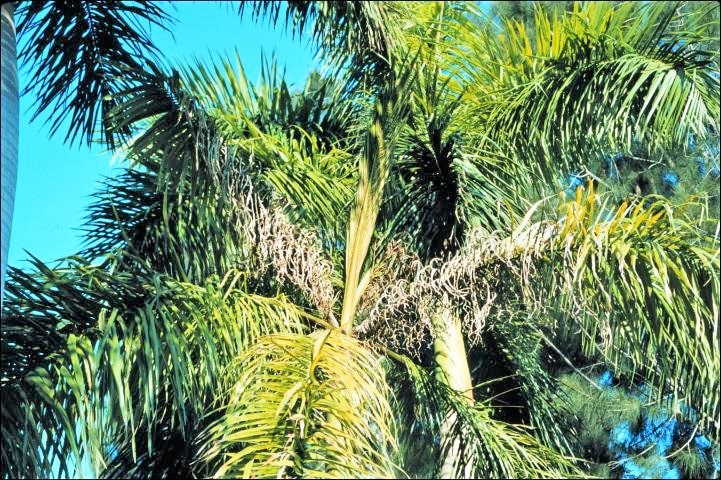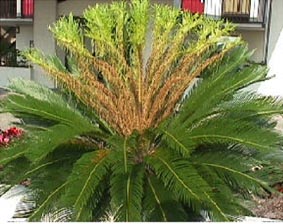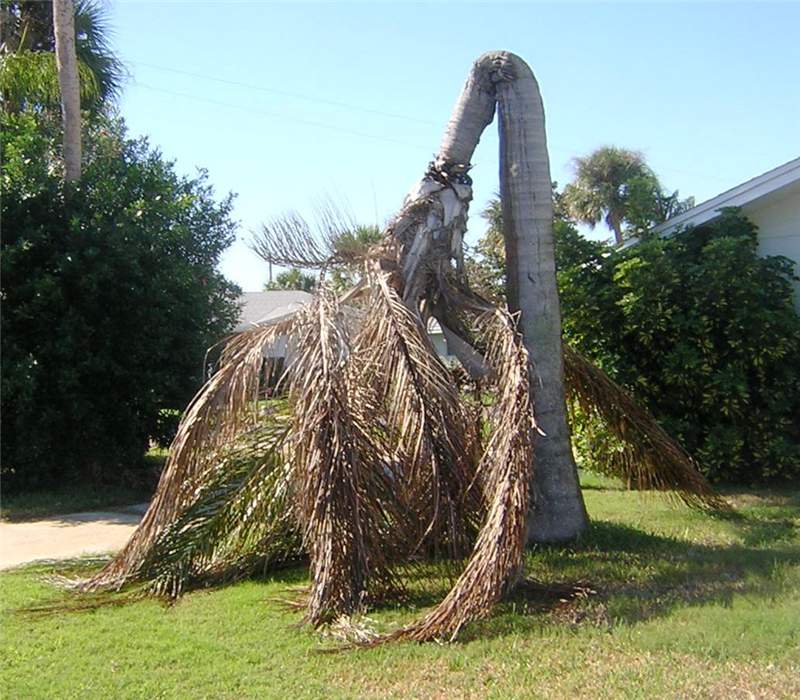Understanding Frizzle Top in Palm Trees
Frizzle top in palm trees is a condition that significantly affects the aesthetic and health of these tropical and subtropical plants. It is primarily characterized by the frizzling or curling of the newer leaves, leading to discoloration, stunted growth, and in severe cases, the death of the palm. This condition is a direct result of a nutrient deficiency, specifically a lack of manganese, an essential microelement that palms require for proper growth and development.
Manganese plays a crucial role in the photosynthesis process, enzyme activation, and the synthesis of chlorophyll. Without adequate manganese, palms cannot efficiently perform these vital functions, leading to the characteristic symptoms of frizzle top. The condition is more prevalent in certain species of palms, including but not limited to Queen Palms, Sago Palms, and Majesty Palms, which are particularly susceptible to manganese deficiency.
Understanding frizzle top in palm trees is the first step towards effectively managing and correcting this condition. Recognizing the signs early and taking prompt action can prevent further damage and help in the recovery of affected palms. It’s important for palm tree owners and gardeners to be aware of the specific needs of their plants, including the essential nutrients required for their health and well-being. By addressing the underlying cause of frizzle top, which is manganese deficiency, one can restore the beauty and vitality of their palm trees, ensuring their longevity and enjoyment for years to come.
Identifying the Signs of Frizzle Top
Recognizing the early signs of frizzle top in palm trees is crucial for timely intervention and treatment. This condition, primarily caused by a manganese deficiency, manifests in several distinct symptoms that can be observed in the foliage and overall health of the palm. The most prominent indicator of frizzle top is the abnormal development of new fronds. These fronds may appear stunted, distorted, or exhibit a frizzled look, hence the name “frizzle top.” The leaves might also show a significant reduction in size compared to healthy fronds, with the tips and edges turning brown or becoming necrotic.
Another key symptom to watch out for is the discoloration of leaves. Affected palms often display a yellowing or chlorosis between the leaf veins, which remains green, creating a striking contrast. This symptom is particularly evident in the newer, emerging fronds. Over time, if the deficiency is not corrected, the palm may cease the production of new fronds altogether, leading to a decline in the palm’s overall health and vigor.
It’s also important to note that while these symptoms are indicative of frizzle top, they can also be signs of other palm tree nutrient deficiencies or diseases. Therefore, accurate diagnosis is essential for effective treatment. Observing the physical condition of your palm trees regularly can help in early detection, allowing for prompt corrective measures to be taken. By familiarizing yourself with these symptoms, you can take proactive steps in maintaining the health and beauty of your palm trees, ensuring they remain a vibrant part of your landscape.

The Role of Manganese in Preventing Frizzle Top
Manganese plays a crucial role in the health and vitality of palm trees, acting as an essential micronutrient that supports various physiological functions. One of the key roles of manganese is in the synthesis of chlorophyll, the green pigment responsible for photosynthesis. Without adequate manganese, palm trees cannot efficiently convert sunlight into the energy they need to grow, leading to weakened overall health and increased susceptibility to diseases and disorders, including frizzle top.
Frizzle top in palm trees is a condition characterized by the frizzled appearance of new leaves, which occurs due to insufficient manganese uptake. This nutrient deficiency prevents the normal development of leaves, causing them to become yellowed, necrotic, and distorted. The impact of manganese deficiency is most visible in the newest growth, as manganese is not a mobile nutrient within the plant. This means that once absorbed by the roots, manganese cannot be redistributed to where it is most needed, making consistent soil availability crucial for the health of the palm.
Ensuring an adequate supply of manganese can prevent the onset of frizzle top symptoms. This involves regular soil testing to monitor manganese levels and the application of manganese supplements when necessary. The use of manganese sulfate, a common treatment for correcting manganese deficiency, can help restore the normal function of the palm’s physiological processes, promoting the healthy development of leaves and overall tree vigor. By addressing manganese deficiency proactively, gardeners and landscapers can maintain the aesthetic appeal and health of their palm trees, preventing the characteristic symptoms of frizzle top from diminishing their landscape’s beauty.
Analyzing the Causes of Manganese Deficiency
Manganese deficiency, a primary culprit behind the frizzle top condition in palm trees, can stem from a variety of sources. Understanding these causes is crucial for effective prevention and treatment. One common cause is high soil pH levels, which can significantly reduce a palm tree’s ability to absorb manganese, even if the nutrient is present in the soil. This is particularly prevalent in areas with alkaline soil.
Another contributing factor is excessive irrigation or rainfall, leading to manganese leaching away from the root zone of palm trees. This scenario is often observed in well-drained soils where water does not stagnate. Similarly, over-fertilization, especially with high phosphorus fertilizers, can inhibit manganese uptake by creating an imbalance of nutrients in the soil. Such an imbalance can cause the available manganese to become bound to other elements, rendering it unavailable to the palm.
Compacted or poorly aerated soils also contribute to manganese deficiency. In compacted soils, root growth is restricted, limiting the palm’s ability to explore the soil for available nutrients, including manganese. Additionally, the use of certain herbicides and pesticides has been linked to reduced micronutrient uptake, including manganese, further exacerbating the deficiency.
Lastly, the natural soil composition and the presence of certain minerals can inherently limit the amount of available manganese. Soils rich in iron, for example, can interfere with manganese absorption due to the competitive uptake mechanisms between these two micronutrients. Recognizing these causes is the first step towards correcting frizzle top in palms, guiding the selection of appropriate treatment methods to restore the health and beauty of these tropical icons.

DIY Soil Testing for Manganese Levels
Understanding the manganese levels in your soil is crucial for preventing and correcting frizzle top in palm trees. A simple DIY soil test can provide valuable insights into whether your palm is suffering from a manganese deficiency, which is a common cause of frizzle top symptoms. Here’s how you can conduct a basic soil test at home:
First, you’ll need to collect a soil sample from around the base of your palm tree. Ensure that the sample is taken from a depth of about 4-6 inches, as this will give you a more accurate representation of the nutrients available to your palm’s roots. It’s best to collect soil from several locations around your tree and mix the samples together for a more comprehensive analysis.
Once you have your soil sample, you can use a DIY soil test kit available at most garden centers or online. These kits typically test for several key nutrients, including manganese. Follow the instructions provided with your kit to test your soil’s manganese levels. Most kits will have you mix a small amount of soil with water and a testing solution, then compare the color of the solution to a chart provided to determine the manganese level.
If the test indicates a manganese deficiency, you’ll need to consider applying a manganese supplement to correct the issue. Keep in mind that soil pH can also affect manganese availability to your palm. In general, more acidic soils (pH below 6) can increase manganese availability, while alkaline soils (pH above 7) can decrease it. If your soil test kit includes a pH test, check this as well to see if pH adjustments may be necessary in addition to manganese supplementation.
DIY soil testing for manganese levels is a straightforward and cost-effective way to diagnose potential nutrient deficiencies contributing to frizzle top. By identifying and addressing these deficiencies early, you can help ensure the health and beauty of your palm trees.
Choosing the Right Manganese Supplement
When it comes to correcting frizzle top in palms, selecting the appropriate manganese supplement is crucial. Manganese sulfate is the most recommended form due to its high solubility and effectiveness in addressing palm tree nutrient deficiency. This compound directly supplies the manganese palms desperately need to recover from frizzle top symptoms.
There are various formulations of manganese supplements available on the market, including granular, powder, and liquid forms. The choice between these options depends on the severity of the deficiency, the size of the palm, and the applicator’s preference. Granular forms are often favored for their ease of application around the base of the palm, slowly releasing manganese as they dissolve into the soil. Powdered manganese sulfate can be dissolved in water and applied directly to the soil or foliage, offering a quicker absorption route. Liquid forms are ready to use and are particularly effective for foliar applications, ensuring that the nutrient is absorbed through the leaves.
When choosing a manganese supplement, it’s essential to consider the product’s purity and the concentration of manganese sulfate. Products with higher purity levels are generally more effective and provide better value for money. It’s also important to read and follow the manufacturer’s instructions regarding dosages and application methods to avoid over-application, which can lead to toxicity issues.
Lastly, while manganese supplements are critical in correcting frizzle top in palms, they should be part of a comprehensive palm tree care program that includes regular monitoring of soil conditions and nutrient levels. This holistic approach ensures that your palms remain healthy and vibrant, effectively preventing the recurrence of frizzle top symptoms.

Step-by-Step Guide to Applying Manganese Supplements
Applying manganese supplements is a critical step in correcting frizzle top in palm trees, a condition marked by palm tree nutrient deficiency. This guide will walk you through the process to ensure your palm trees receive the essential nutrients they need for healthy growth.
Step 1: Choose the Right Manganese Supplement – Manganese sulfate is the most recommended treatment for frizzle top symptoms. It’s readily available and easy for palm trees to absorb. Ensure you purchase a high-quality product specifically designed for palm tree care.
Step 2: Read the Instructions – Before applying any manganese sulfate treatment, carefully read the product’s instructions. Dosage and application methods can vary, so it’s crucial to follow the guidelines provided by the manufacturer.
Step 3: Prepare the Solution – If you’re using a water-soluble manganese sulfate product, dissolve the recommended amount in water. For granular types, you might need to spread the granules around the base of the palm tree.
Step 4: Apply the Manganese Supplement – For liquid solutions, use a garden sprayer to apply the mixture directly to the soil around the palm tree’s base, ensuring even coverage. For granular supplements, evenly distribute the granules in a circle around the palm, extending out to the drip line.
Step 5: Water the Area – After applying the manganese supplement, water the area thoroughly. This helps to disperse the manganese into the soil, making it more accessible to the palm tree’s roots.
Step 6: Repeat if Necessary – Correcting frizzle top in palms may require multiple applications, especially if the deficiency is severe. Monitor your palm tree’s condition and repeat the treatment according to the product’s recommendations or as advised by a palm tree care professional.
Remember, while manganese supplements are essential in treating frizzle top, they are just one part of a comprehensive palm tree care regimen. Regular monitoring and maintenance are crucial for the long-term health of your palm trees.
The Importance of Regular Monitoring and Maintenance
Regular monitoring and maintenance are crucial in the fight against frizzle top in palm trees. This condition, marked by a palm tree nutrient deficiency, specifically manganese, can severely affect the health and appearance of your palms if left unchecked. By establishing a routine of careful observation and timely intervention, you can prevent the onset of frizzle top symptoms or mitigate their impact if they do occur.
Monitoring your palm trees involves looking for early signs of frizzle top, such as frizzled, distorted new growth, and yellowing or browning of leaf edges. Early detection is key to preventing the spread and worsening of the condition. It allows for quicker, more effective treatment, often leading to a full recovery of the affected palm. Regularly inspect your palms, focusing on their new growth, as this is where symptoms first appear.
Maintenance includes ensuring your palm trees receive the right balance of nutrients, water, and sunlight. Manganese sulfate treatment is a common remedy for correcting frizzle top in palms. However, applying it correctly and at the right time is essential for its success. Follow the instructions for your chosen manganese supplement carefully, and apply it as part of your regular palm tree care routine.
Additionally, maintaining the soil’s health around your palms is vital. Soil testing for manganese levels can help you understand your soil’s specific needs and adjust your care regimen accordingly. This proactive approach to palm tree care helps in preventing nutrient deficiencies and other conditions that can lead to frizzle top.
In summary, regular monitoring and maintenance are indispensable for keeping your palm trees healthy and free from frizzle top. By staying vigilant and providing your palms with the necessary care and nutrients, you can enjoy the beauty and benefits of healthy palm trees for years to come.
Additional Care Tips for Healthy Palm Trees
Caring for palm trees extends beyond addressing nutrient deficiencies like frizzle top. To ensure the overall health and longevity of your palm trees, consider these additional care tips. First, water your palms adequately. Palms prefer deep, but infrequent watering to encourage strong root growth. Over-watering can lead to root rot, while under-watering can stress the tree, making it more susceptible to diseases.
Next, ensure your palm trees are planted in well-draining soil. Poor drainage can cause water to accumulate around the roots, leading to various health issues. If drainage is a concern, consider amending the soil with sand or organic matter to improve water flow.
Pruning is also essential for maintaining palm tree health. Remove dead or dying fronds to prevent pests and diseases from taking hold. However, avoid over-pruning or cutting too close to the trunk, as this can harm the tree. Always use clean, sharp tools to make clean cuts.
Protecting your palm trees from extreme weather is crucial, especially for young or newly planted trees. Use frost cloths or blankets to cover your palms during cold snaps, and provide shade or windbreaks to protect them from scorching sun and strong winds.
Finally, monitor your palm trees regularly for signs of pests or diseases. Early detection is key to preventing minor issues from becoming major problems. If you notice unusual symptoms, such as discolored fronds or stunted growth, take action immediately to diagnose and treat the issue.
By following these additional care tips, you can help ensure your palm trees remain healthy, vibrant, and free from issues like frizzle top. Remember, consistent care and attention are the keys to thriving palm trees.
When to Seek Professional Help for Frizzle Top Treatment
While many gardeners and palm tree enthusiasts are successful in treating frizzle top through diligent care and the right supplements, there are instances when seeking professional help is the best course of action. Knowing when to call in the experts can save you time and ensure your palm trees receive the best possible care.
Firstly, if you’ve applied manganese supplements according to guidelines and haven’t seen improvement in your palm trees within a few months, it might be time to consult a professional. Persistent symptoms of frizzle top, despite correct treatment, could indicate a more complex underlying issue that requires specialized knowledge to diagnose and treat.
Secondly, if your palm trees are large or if the frizzle top is widespread among several trees, professional arborists can provide services that might be difficult or unsafe for an individual to undertake. This includes deep root fertilization or the application of treatments at heights.
Additionally, professionals can offer a comprehensive soil analysis that goes beyond manganese levels, identifying other potential nutrient deficiencies or pH imbalances that could be contributing to the problem. This holistic approach ensures that all factors affecting the health of your palm trees are addressed.
Lastly, if you’re unsure about the diagnosis of frizzle top or the best treatment options, a professional can provide clarity and peace of mind. They can confirm the presence of frizzle top and recommend a tailored treatment plan, taking into account the specific needs of your palm trees and soil conditions.
In conclusion, while many cases of frizzle top can be managed with the right knowledge and care, don’t hesitate to seek professional help when needed. Doing so can ensure the health and longevity of your palm trees, preserving their beauty and value for years to come.
